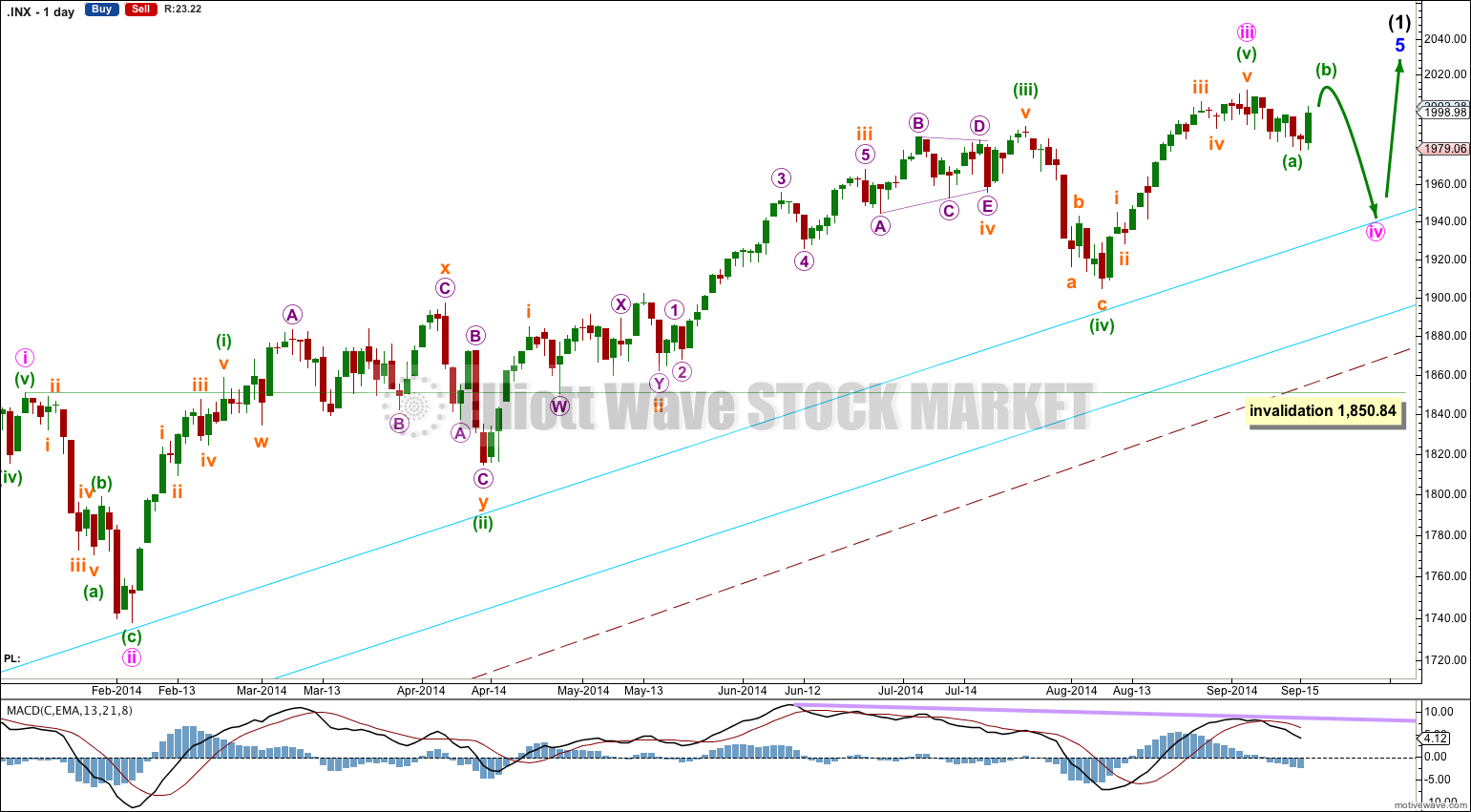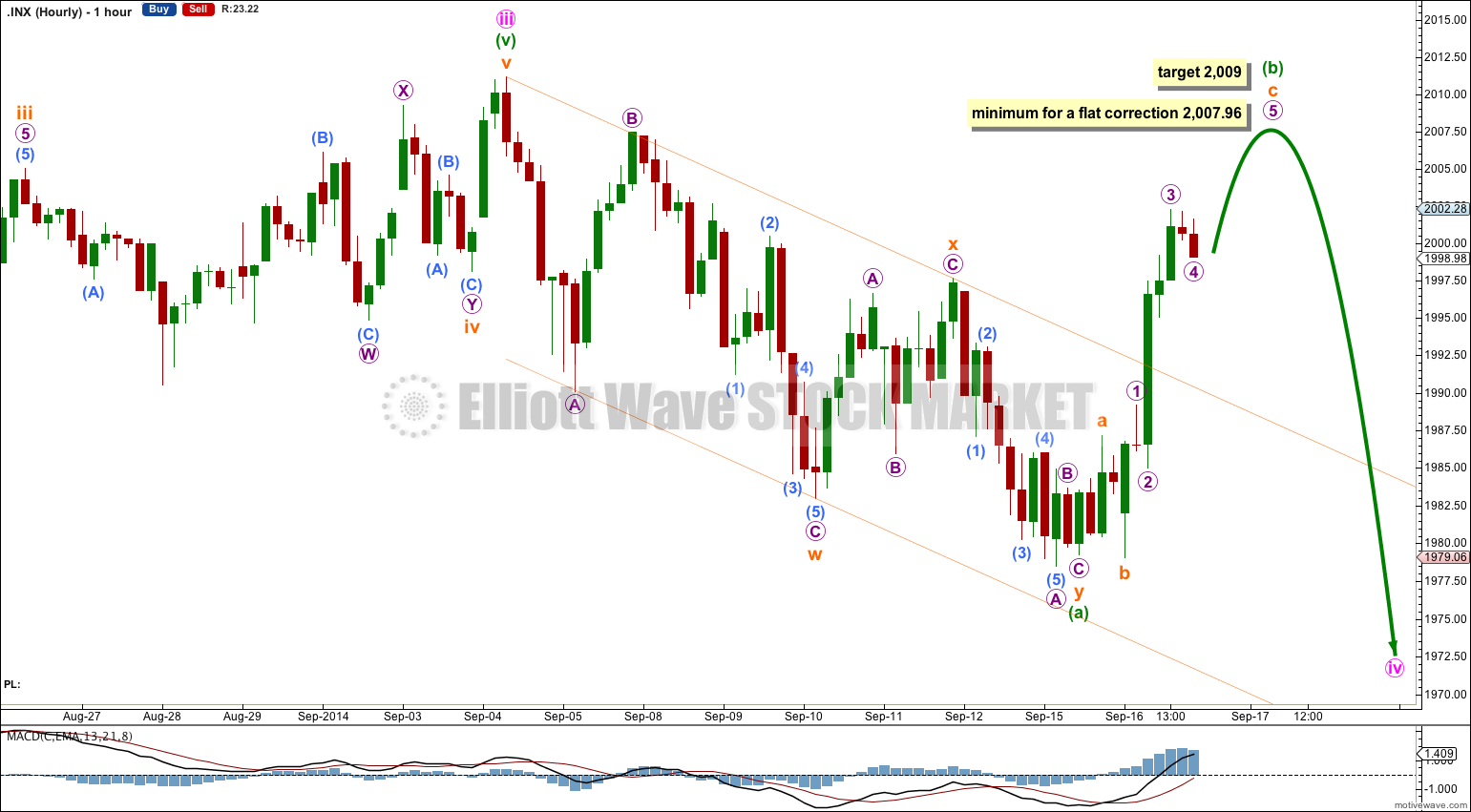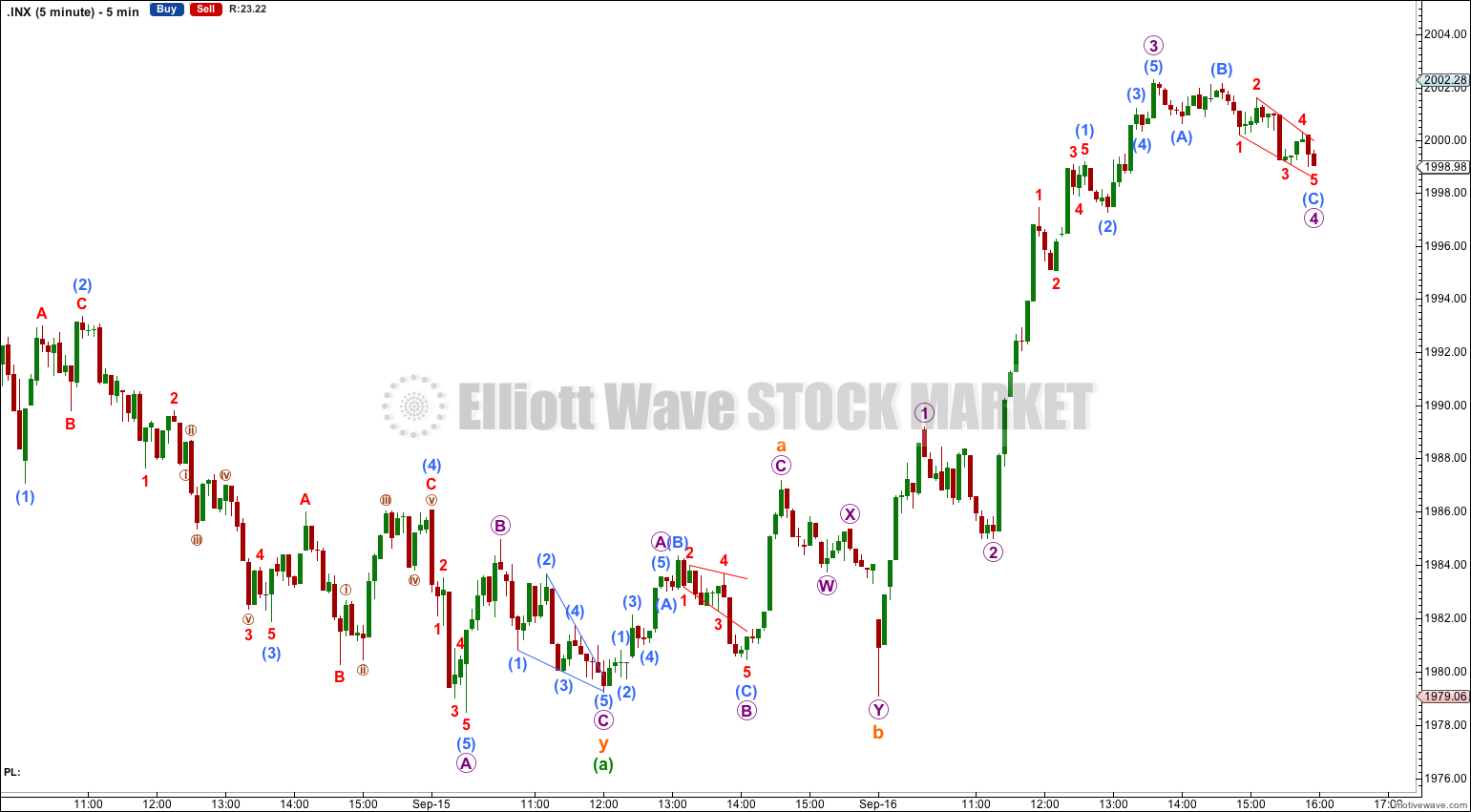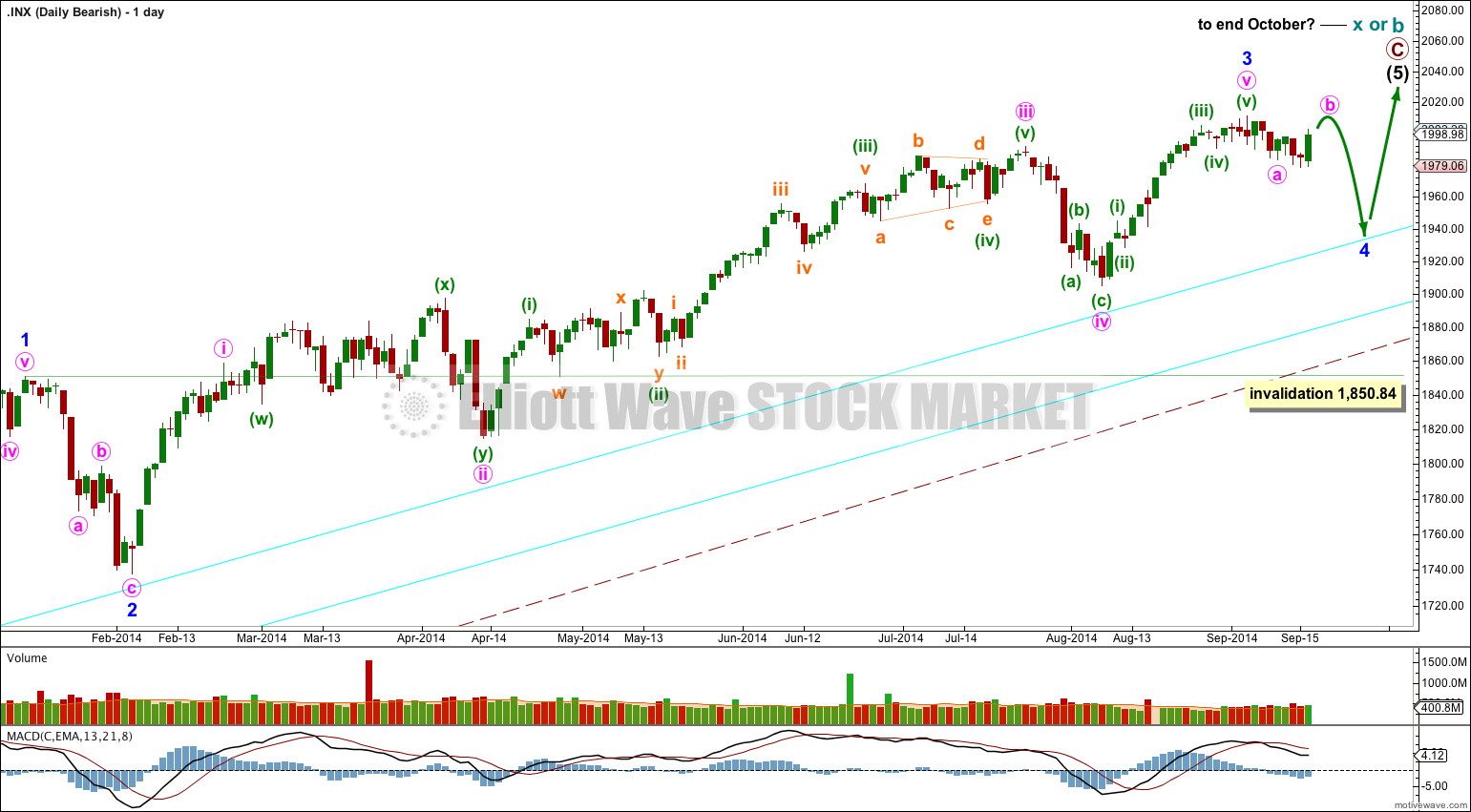I had expected Wednesday’s session to begin with more downwards movement to a target at 1,975. The session did begin with a little downward movement, but not to a new low and the target was not reached. Thereafter, upwards movement was expected.
Summary: Tomorrow I expect at least a little more upwards movement. The short term target is at 2,009. Thereafter, we should see either a five down for a C wave, or overlapping movement for a few days to complete a triangle.
Click on charts to enlarge.
Bullish Wave Count.
The aqua blue trend lines are critical. Draw the first trend line from the low of 1,158.66 on 25th November, 2011, to the next swing low at 1,266.74 on 4th June, 2012. Create a parallel copy and place it on the low at 1,560.33 on 24th June, 2013. While price remains above the lower of these two aqua blue trend lines we must assume the trend remains upwards. This is the main reason for the bullish wave count being my main wave count.
There are a couple of things about this wave count of which I am confident. I see minor wave 3 within intermediate wave (1) as over at 1,729.86 (19th September, 2013). It has the strongest upwards momentum and is just 0.76 longer than 2.618 the length of minor wave 1. At 455 days duration this is a remarkably close Fibonacci ratio. The subdivisions within it are perfect. If this is correct then minor wave 4 ends at 1,646.47 and this is where minor wave 5 begins.
Because there is already a very close Fibonacci ratio between minor waves 1 and 3 I would not actually expect to see a Fibonacci ratio between minor wave 5 to either of 1 or 3. This means that the target for intermediate wave (1) to end would best be calculated at minute wave degree, within minor wave 5. I will not be able to do that until minute wave iv has ended.
Minor wave 5 is unfolding as an impulse. If minor wave 5 has passed its middle then I would expect to see more divergence between price and MACD develop over coming weeks.
There is no Fibonacci ratio between minute waves iii and i. This makes it more likely we shall see a Fibonacci ratio between minute wave v and either of iii or i, so when minute wave iv is complete I should be able to calculate a target with a reasonably good probability.
Minute wave ii lasted 14 sessions and was a relatively deep 55% zigzag correction. Given the guideline of alternation I would expect minute wave iv to be a more shallow sideways correction. It is most likely to be a flat, double flat, combination or triangle. These structures tend to be long lasting, so I would expect it may take longer than three weeks.
Combinations, expanded flat corrections and running triangles may all include new price extremes beyond their starts. Minute wave iv may include a new high above 2,011.17, should be very choppy and overlapping, and will be difficult to analyse (alternate wave counts will be necessary). While it is unfolding the wave count will change. There are more than thirteen possible structures it may take.
I would expect minute wave iv to end short of the upper aqua blue trend line, continuing a pattern the S&P has shown now for over a year.
The large maroon – – – channel is copied over from the weekly chart. It is drawn in exactly the same way on bull and bear wave counts. For the bull wave count this channel is termed a base channel about primary waves 1 and 2. A lower degree second wave should not breach the lower edge of a base channel drawn about a first and second wave one or more degrees higher. The lower maroon – – – trend line differentiates the bull and bear wave counts at cycle degree and monthly chart level.
A careful analysis of recent movement on the five minute chart sees my wave count changed a little. I expect the double zigzag for minuette wave (a) was already over. Minuette wave (b) is an almost complete expanded flat correction.
Within minuette wave (b) subminuette wave b is 105% the length of subminuette wave a. Subminuette wave c is almost complete and may not exhibit a Fibonacci ratio to subminuette wave a.
Within subminuette wave c micro wave 3 is 0.97 longer than 1.618 the length of micro wave 1. At 2,009 micro wave 5 would reach equality in length with micro wave 1. If micro wave 4 moves lower this target must move correspondingly lower.
At this stage minute wave iv may be either a flat, double flat, combination (with the first flat incomplete as labeled here) or a triangle. There are still several structural possibilities for minute wave iv.
If minute wave iv is a flat correction then within it minuette wave (b) must reach a minimum of 90% the length of minuette wave (a) at 2,007.96. An expanded flat (the most common type) may see minuette wave (b) move above the start of minuette wave (a) above 2,011.17.
If minute wave iv is a triangle there is no minimum requirement for upwards movement tomorrow. If minute wave iv is a running triangle then minuette wave (b) within it may move beyond the start of minuette wave (a) above 2,011.17.
If minute wave iv is a flat correction then when minuette wave (b) is over minuette wave (c) should be a five wave structure downwards, and would most likely make a new low below 1,979.22 to avoid a truncation.
If minute wave iv is a contracting or barrier triangle then minuette wave (c) may not move beyond the end of minuette wave (a) at 1,979.22.
Bearish Alternate Wave Count
This bearish alternate wave count expects that the correction is not over. The flat correction which ended at 666.79 was only cycle wave a (or w) of a larger super cycle second wave correction.
The structure and subdivisions within primary wave C for the bear wave count are the same as for intermediate wave (1) for the bull wave count. Thus the short to mid term outlook is identical.
The differentiation between the bull and bear wave count is the maroon – – – channel. The bull wave count should see price remain above the lower maroon – – – trend line. The bear wave count requires a clear breach of this trend line. If this trend line is breached by a full weekly candlestick below it and not touching it then this bear wave count would be my main wave count and I would then calculate downwards targets.
We should always assume the trend remains the same until proven otherwise; the trend is your friend. While price remains above the lower maroon – – – trend line I will assume that the S&P 500 remains within a bull market.
This analysis is published about 08:50 p.m. EST.





Hi Lara, I thought minuette wave b had to be a 5-3-5 combination as a correction, or as a possible flat can it be a 3-3-5 combo?
B waves can be any corrective structure.
I think this one is a 3-3-5 expanded flat.